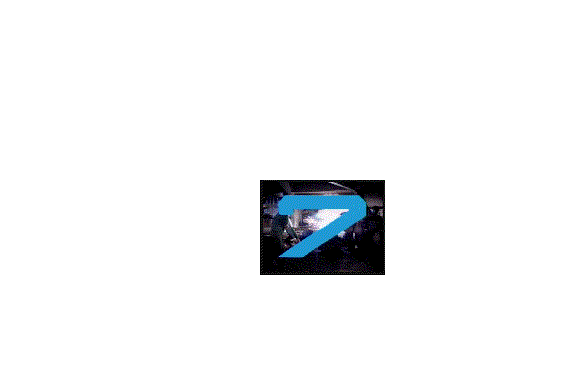|
For three years, CBS presented us with an odd mixture. A pioneer family lost somewhere in the stars, battling wierd creatures and facing the day to day survival needs of a hostile environment. Despite this, the Robinson family and Major Don West remain invariably brave. Doctor Zachary Smith is another case entirely! The basic concept of the show sounds fun, and was in fact the reason why CBS rejected Star Trek when Gene Roddenberry made his pitch to the network. They felt that Lost in Space was more commercial. Considering that it ran just as long, their decision seems justified. Whether the show was as intriguing and clever as Star Trek is quite another matter. In ratings, it was quite comparable. The family Robinson, consisting of father, mother, two daughters and precocious son, pilot West and stowaway Smith are lost somewhere in the stars. They are attempting to reach Alpha Centauri, but they have considerable trouble making the destination. Sometimes for technical reasons, other times due to alien interference.
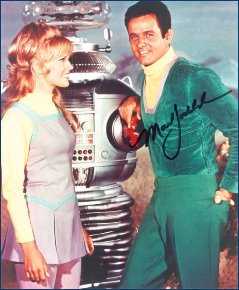 Like all shows from the Irwin Allen stable, Lost in Space was clearly aimed at a family audience. Father John Robinson (who somehow managed to become promoted from a mere Doctor to a full Professor during the first season) is tough, cheerful, reliable and a good father. Mother Maureen is cheerful and very compassionate. Eldest daughter Judy is there for Major West. There are times she gets her hair done by one of the wonderful machines packed aboard their spaceship, the Jupiter 2. Eldest daughter Judy is there for Major West. There are times she gets her hair done by one of the wonderful machines packed aboard their spaceship, the Jupiter 2. Younger daughter Penny is cheerful, loves animals of whatever species, though she lost a pet somewhere in the course of the third season and didn't seem to miss it, and experiences the frequent growing pains as she matures. Will, the precocious one is cheerful, naive and downright credulous where the lies of Dr. Smith are concerned. He's frighteningly brilliant, and can cobble almost anything together from a $10 electronics kit! With the family remaining cheerful under all circumstances, it is clearly good, solid picnic fun. The fact that the first season features them using a nice tracked device called the Chariot for moving about really adds to the atmosphere of levity! The additional crewmembers are Major Don West, Dr. Smith and the robot. West is not always so cheerful, staunch and adventurous. He dislikes Smith a lot and continually threatens to beat his lights out, but henever does. The robot is actually the most fascinating member of the crew. Misprogrammed at the start by Smith, it begins as a hulking bad guy, then slowly transforms into the most lovable member of the cast.
Like all shows from the Irwin Allen stable, Lost in Space was clearly aimed at a family audience. Father John Robinson (who somehow managed to become promoted from a mere Doctor to a full Professor during the first season) is tough, cheerful, reliable and a good father. Mother Maureen is cheerful and very compassionate. Eldest daughter Judy is there for Major West. There are times she gets her hair done by one of the wonderful machines packed aboard their spaceship, the Jupiter 2. Eldest daughter Judy is there for Major West. There are times she gets her hair done by one of the wonderful machines packed aboard their spaceship, the Jupiter 2. Younger daughter Penny is cheerful, loves animals of whatever species, though she lost a pet somewhere in the course of the third season and didn't seem to miss it, and experiences the frequent growing pains as she matures. Will, the precocious one is cheerful, naive and downright credulous where the lies of Dr. Smith are concerned. He's frighteningly brilliant, and can cobble almost anything together from a $10 electronics kit! With the family remaining cheerful under all circumstances, it is clearly good, solid picnic fun. The fact that the first season features them using a nice tracked device called the Chariot for moving about really adds to the atmosphere of levity! The additional crewmembers are Major Don West, Dr. Smith and the robot. West is not always so cheerful, staunch and adventurous. He dislikes Smith a lot and continually threatens to beat his lights out, but henever does. The robot is actually the most fascinating member of the crew. Misprogrammed at the start by Smith, it begins as a hulking bad guy, then slowly transforms into the most lovable member of the cast.
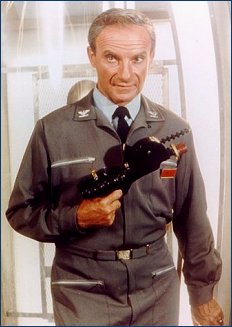 He garnered the largest pile of mail. Oddly enough, the two actors who gave him life were never even listed in the credits. They were Bob May in the suit and Dick Tufeld at the microphone. (Take a belated bow fellas!) The robot is the only one with funny lines and is gifted with a terrific personality. Unlike the rest of the crew and Major West, he isn't cheerful! In fact, he's often downright grumpy. "Warning! Warning! Alien presence!" he yells, arms flailing and is totally ignored despite the fact that he is always right! There remains only Doctor Zachary Smith, part time spy and full time pain in the neck. In the beginning, the doctor of intergalactic environmental psychology is cold, vicious and just plain nasty. That was clearly considered unwholesome for the show by some power-that-be (and Jonathan Harris himself) and Smith suddenly transforms into a bumbling, greedy cretin, whose idiotic complacency and incredibly large ego constantly bring trouble upon the family. "Oh the pain, the pain," he often moaned. I wonder why the family often let their young son Will hang around with him considering his list of imbecilic crimes. Without his fumbling farcical attempts to return to Earth or to rake in piles of money, there would be very few adventures indeed. You have to admit, Harris did a good job playing the part. This wonderful, cheerful, family and their thorn in the side, have inumerable escapades. He garnered the largest pile of mail. Oddly enough, the two actors who gave him life were never even listed in the credits. They were Bob May in the suit and Dick Tufeld at the microphone. (Take a belated bow fellas!) The robot is the only one with funny lines and is gifted with a terrific personality. Unlike the rest of the crew and Major West, he isn't cheerful! In fact, he's often downright grumpy. "Warning! Warning! Alien presence!" he yells, arms flailing and is totally ignored despite the fact that he is always right! There remains only Doctor Zachary Smith, part time spy and full time pain in the neck. In the beginning, the doctor of intergalactic environmental psychology is cold, vicious and just plain nasty. That was clearly considered unwholesome for the show by some power-that-be (and Jonathan Harris himself) and Smith suddenly transforms into a bumbling, greedy cretin, whose idiotic complacency and incredibly large ego constantly bring trouble upon the family. "Oh the pain, the pain," he often moaned. I wonder why the family often let their young son Will hang around with him considering his list of imbecilic crimes. Without his fumbling farcical attempts to return to Earth or to rake in piles of money, there would be very few adventures indeed. You have to admit, Harris did a good job playing the part. This wonderful, cheerful, family and their thorn in the side, have inumerable escapades.
 The show remained quite high in the ratings for three years (from September 15, 1965 until September 11, 1968), and still syndicates pretty well in the reruns racket, so despite any failings the show may have had, it clearly has some appeal. The reason isn't that hard to find. It's the family picnic. Watching the series, you feel involved with the everyday life of a normal, albeit spacefaring, family. The technical and special effects requirements of Lost in Space were undoubtedly among the most demanding ever posed by a television series of that time. Great stress had been laid on visual and mechanical effects, in order that the Lost in Space audience really kind of felt the drama of the series' strange and bizarre world. To simulate the landscape of the planet on which the Robison family is marooned, one of the 20th Century-Fox largest sound studios had been transformed into an eerie vista of unusual vegetation and peculiarly shaped boulders. The show remained quite high in the ratings for three years (from September 15, 1965 until September 11, 1968), and still syndicates pretty well in the reruns racket, so despite any failings the show may have had, it clearly has some appeal. The reason isn't that hard to find. It's the family picnic. Watching the series, you feel involved with the everyday life of a normal, albeit spacefaring, family. The technical and special effects requirements of Lost in Space were undoubtedly among the most demanding ever posed by a television series of that time. Great stress had been laid on visual and mechanical effects, in order that the Lost in Space audience really kind of felt the drama of the series' strange and bizarre world. To simulate the landscape of the planet on which the Robison family is marooned, one of the 20th Century-Fox largest sound studios had been transformed into an eerie vista of unusual vegetation and peculiarly shaped boulders.
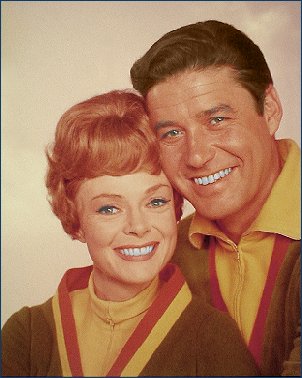 Another such studio was used for the water voyage sequences and a huge manmade moat, made to look as if nature had gone wild, for the sea scenes requiring an outdoor backdrop. June was reared in Hollywood and is the daughter of the late great character actor Gene Lockhart. She broke into the movies at the age of 16, but stardom eluded her until the age of 21 when she became the toast of Broadway in the play For Love or Money. That was in 1945. She won a Tony and three other major awards that year, and Hollywood made a belated discovery of her talents. Guy, a native of New York City (June was born there too, but only lived there a short while), had to go to Hollywood to find his fame. After a few films for Universal Studios, he became Disney's swashbuckling Zorro on TV. Result: Instant fame! He later made movies all over Italy, Germany and England before returning to Hollywood for a short run in the series Bonanza and eventually his role as Professor John Robinson. He was in his early 40's while filming Lost in Space. Guy, a towering 6' 3", had hazel eyes and an exuberant athletic nature, became quite the heartthrob for female fans. Both June and Guy shared a love of sports, especially swimming and tennis. Looking back over the years, Lost in Space seems to have been the first really neat sci fi show. It had some faults, yet it also had a number of charms including quite a few fine guest stars. Another such studio was used for the water voyage sequences and a huge manmade moat, made to look as if nature had gone wild, for the sea scenes requiring an outdoor backdrop. June was reared in Hollywood and is the daughter of the late great character actor Gene Lockhart. She broke into the movies at the age of 16, but stardom eluded her until the age of 21 when she became the toast of Broadway in the play For Love or Money. That was in 1945. She won a Tony and three other major awards that year, and Hollywood made a belated discovery of her talents. Guy, a native of New York City (June was born there too, but only lived there a short while), had to go to Hollywood to find his fame. After a few films for Universal Studios, he became Disney's swashbuckling Zorro on TV. Result: Instant fame! He later made movies all over Italy, Germany and England before returning to Hollywood for a short run in the series Bonanza and eventually his role as Professor John Robinson. He was in his early 40's while filming Lost in Space. Guy, a towering 6' 3", had hazel eyes and an exuberant athletic nature, became quite the heartthrob for female fans. Both June and Guy shared a love of sports, especially swimming and tennis. Looking back over the years, Lost in Space seems to have been the first really neat sci fi show. It had some faults, yet it also had a number of charms including quite a few fine guest stars.
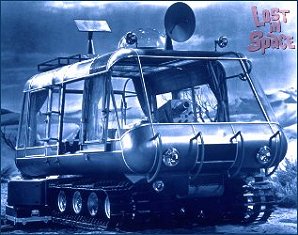
An article in TV Star Parade Magazine, 1966: Though the actors on Lost in Space all come from solid acting backgrounds, it's the special effects that steal the show. In the first place, they are the most expensive in TV history. $650,000 was spent before the series even went into production. Each episode is budgeted at about $200,000 and Irwin Allen, in a rare moment of candor, confided that the sets alone cost $350,000 and "if this show doesn't stay on the air three years, everyone will be bankrupt." They are also marvelously authentic. Unlike less ambitious programs which settle for scale models, Allen has insisted on the real thing. The parent space craft, for instance, is 60 feet long and two stories high. It is packed with castoff and obsolete equipment wooed from our nation's genuine space program.
 And the head of the show's research department is in contact with Washington constantly to make sure that visual effects and scientific dialogue are accurate and as modern as tomorrow. The landscapes, which June Lockhart herself describes as "spooky", are given the same careful attention. The pilot film was shot at Death Valley. Now location work is done among the misshapen rocks of California's Red Rock Canyon and back at the studio. Two of 20th's largest sound stages have been turned over to Lost in Space. On one, there has been devised an eerie vista of unusual vegetation and peculiarly shaped boulders. On the other, a vast man-made moat, made to look as if nature had gone wild, serves as a backdrop for all water scenes. The space-farer's basic costumes are brilliant silver and red lamé jump suits worn with silver boots. They're more lightweight than they look, but June still has a complaint. "My suit's so tight I can't sit down," she says. Guy Williams also has a complaint. For his walks in space, he's fitted to a harness and dangled from wires attached to a trolley line high up on the sound stage ceiling. A technician reels him in and out by pressing buttons. But they keep testing new wires on him and Guy's afraid of being dropped. His solution? He keeps telling the special effects men he's ten pounds heavier than he really is. And the head of the show's research department is in contact with Washington constantly to make sure that visual effects and scientific dialogue are accurate and as modern as tomorrow. The landscapes, which June Lockhart herself describes as "spooky", are given the same careful attention. The pilot film was shot at Death Valley. Now location work is done among the misshapen rocks of California's Red Rock Canyon and back at the studio. Two of 20th's largest sound stages have been turned over to Lost in Space. On one, there has been devised an eerie vista of unusual vegetation and peculiarly shaped boulders. On the other, a vast man-made moat, made to look as if nature had gone wild, serves as a backdrop for all water scenes. The space-farer's basic costumes are brilliant silver and red lamé jump suits worn with silver boots. They're more lightweight than they look, but June still has a complaint. "My suit's so tight I can't sit down," she says. Guy Williams also has a complaint. For his walks in space, he's fitted to a harness and dangled from wires attached to a trolley line high up on the sound stage ceiling. A technician reels him in and out by pressing buttons. But they keep testing new wires on him and Guy's afraid of being dropped. His solution? He keeps telling the special effects men he's ten pounds heavier than he really is.
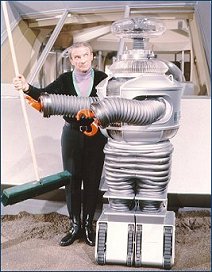 To viewers, the most interesting member of the exhibition is the robot. It is designed by art director Robert Kinoshita and prop builder Bob Stewart. It weighs in at 275 pounds and stands 6'4". The cost is estimated at $36,000. He has a bubble head of clear plastic, accordion-style arms and legs, claw hands and a body of aluminum, rubber and plastic. Other features are radar-antennae "ears", a "heart" that glows when excited and intricate computer systems. Among other functions, he is programmed to lift 50,000 tons, play chess and take soil samples. Just how many of the accomplishments are practical? How many are performed independently by the robot? Kinoshita and Stewart say that's a trade secret. And so does Irwin Allen. Asked if the robot can really speak, the three who know might answer, "It does not compute." They admit, however, that the robot is not as invulnerable or infallible as he appears to be. For one thing, after performing in the first three episodes, he already has had to have a new set of legs. Luckily, Kinoshita and Stewart have a supply of spare parts on hand. Even that doesn't account for the loss of one day's shooting when the robot wouldn't cooperate. His handler, John Borgese, blamed it on a power failure.
To viewers, the most interesting member of the exhibition is the robot. It is designed by art director Robert Kinoshita and prop builder Bob Stewart. It weighs in at 275 pounds and stands 6'4". The cost is estimated at $36,000. He has a bubble head of clear plastic, accordion-style arms and legs, claw hands and a body of aluminum, rubber and plastic. Other features are radar-antennae "ears", a "heart" that glows when excited and intricate computer systems. Among other functions, he is programmed to lift 50,000 tons, play chess and take soil samples. Just how many of the accomplishments are practical? How many are performed independently by the robot? Kinoshita and Stewart say that's a trade secret. And so does Irwin Allen. Asked if the robot can really speak, the three who know might answer, "It does not compute." They admit, however, that the robot is not as invulnerable or infallible as he appears to be. For one thing, after performing in the first three episodes, he already has had to have a new set of legs. Luckily, Kinoshita and Stewart have a supply of spare parts on hand. Even that doesn't account for the loss of one day's shooting when the robot wouldn't cooperate. His handler, John Borgese, blamed it on a power failure.
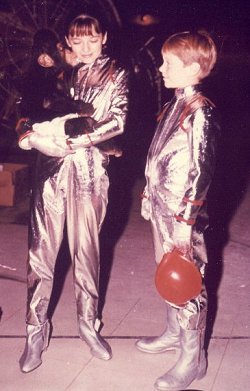
But who knows? Perhaps the robot was just tired of being referred to as "Junior" around the set, as "Stu" by his builder or as "Blinky" by his designer. Not having a proper stage name or billing is enough to upset any performer. The robot, along with the space explorers, has faced a weird series of animals and people. Traveling with the group as Angela Cartwright's pet is the Bloop, a chimp who wears a long-eared wig for her part. Encountered in another episode were ostriches tastefully attired in pantaloons and top knots. When the "Bubble People" appeared in the script, they were represented by plastic mobiles hung in a floor to ceiling sea of wispy fibres. According to columnist Kay Gardella, it "looked like cotton candy." But perhaps the most spectacular creation of the show so far was the 40-foot giant who menaced the travelers in an early episode. He was played by Lamar Lundy, a 265-pound football star for the Los Angeles Rams. Lundy stands 6'6" to start with. He was padded, built up and wrapped in a costume made from the bark of some thirty palm trees. A single huge eye (which moved) was applied to the middle of his forehead and he was given claw-like appendages to serve as his hands and feet. Carefully angled photography did the rest. "He made a fine giant," said Allen. "Just the sort of thing you'd expect on some strange planet." Then a dreamy look came into his eye, and you knew that some bigger, better secret scheme was already in his mind. But he won't tell you what! You'll have to watch it on CBS-TV. Guy's Screen Test>>
|
